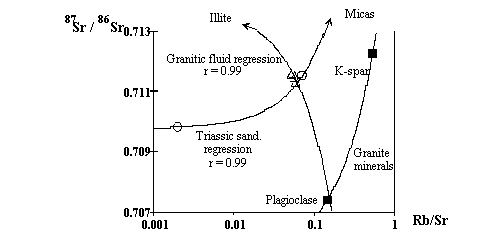
Saline fluids have been recovered and analysed during the last years in the Rhine graben (Alsace, France), both in the sandstone aquifer of the Triassic and the underlying granitic basement at depth and temperature ranging from 1400 to 3500 m and 70 to 160°C. New analytical data (trace elements and Sr isotopic measurements) of several fluids previously sampled, and a complete analysis of a fluid collected in 1993 at 3500 m depth in the granite are presented. The Rhine graben samples are compared in order to distinguish respective influences of temperature and host-rock in the water-rock interaction processes.
It shows that sulphates have been dissolved by the fluids, also leading to Br enrichments. Dissolution of the micas has strongly increased the Rb and Cs and Li contents which concentration give a measurement of the water-rock interaction degree.
The Sr isotopic ratios allow to compare the fluids to the minerals of the granite (Figure). It evidences two different relations for the fluids in the sandstone and those in the granite. These trend can be related to different minerals dissolution : plagioclase and illite in the granite, micas in the sandstone. The major implication of this evolution is that (1) the fluids of the granite and those of the Buntsandstein have undergone two separated evolution; (2) chronologically, it implicates that the fluids have firstly evolved in the Buntsandstein before to interact with the granite. It seems from this scheme that the inflow of fluids in the granite has constituted a discrete event which has completely separated two distinct evolutions.
The cation concentrations are mainly related to the temperature effect, independently of the host-rocks. The equilibrium has mainly caused Ca and K concentration variations which result in clear Ca - K correlation, and Ca or K correlation with the oxygen isotopic ratio.
Geothermometric computations indicate that with increasing depth, the cations, and the silica and d18O(SO4) geothermometers tend to become closer to a value of 230°C. It demonstrates the existancy of a hot reservoir in the granite of the graben, at a depth which can be estimated between 4,5 and 5 km depth. It is infered that the fluids sampled at the Soultz geothermal site circulate within the granite down to that depth where they are hotted. Such circulations are due to the existency of intra-granitic convection cells extending from 2 to 5 km depth in the granite along the fault network.